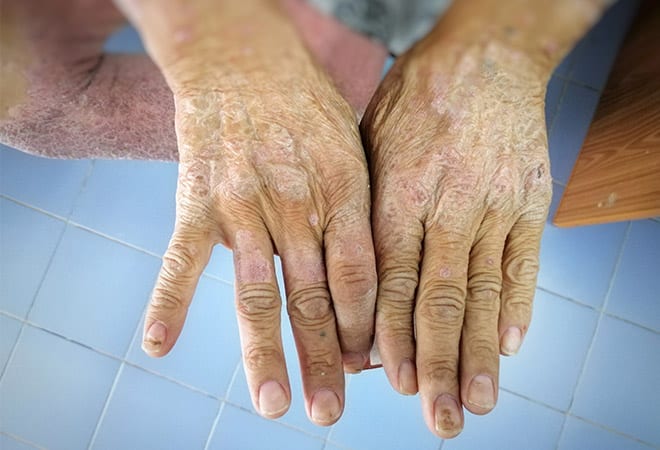
Psoriatic Arthritis: Symptoms, Causes, and Treatment Options
Psoriatic arthritis (PsA) is a chronic inflammatory condition that affects both the joints and skin, often linked to the autoimmune disease psoriasis. PsA can significantly impact quality of life, causing joint pain, stiffness, and skin lesions in people who have psoriasis, but early diagnosis and treatment can manage symptoms and prevent progression. The National Psoriasis Foundation (NPF) estimates that up to 30% of people with psoriasis develop PsA, affecting millions globally.
What is Psoriatic Arthritis?
Psoriatic arthritis is an autoimmune condition combining joint inflammation (arthritis) with the skin symptoms of psoriasis. It is classified as a seronegative spondyloarthropathy, often affecting joints asymmetrically and varying in severity. PsA can affect any joint, including fingers, toes, knees, and the spine, and may involve enthesitis (inflammation where tendons/ligaments meet bone) or dactylitis (sausage-like swelling of fingers/toes). If left untreated, psoriatic arthritis can cause significant joint damage. Early treatment is critical to prevent irreversible joint damage and improve quality of life.
Rheumatoid Arthritis: Causes, Symptoms, Prevention, and Treatment
Causes and Risk Factors of Psoriatic Arthritis
The exact cause of PsA is unknown, but it involves a combination of genetic, immune, and environmental factors. The Mayo Clinic states, “Psoriatic arthritis occurs when your body’s immune system attacks healthy cells and tissue”.
Causes
- Autoimmune Dysfunction: The immune system mistakenly attacks joints and skin, causing inflammation. PsA is driven by immune-mediated inflammation involving T-cells and cytokines like TNF-alpha.
- Genetics: A family history of psoriasis or PsA increases risk. Having a first-degree relative with psoriasis increases your risk of developing psoriatic arthritis.
- Environmental Triggers: Infections, physical trauma (e.g., Koebner phenomenon), or stress can trigger PsA in predisposed individuals.
Risk Factors
- Psoriasis: Up to 30% of psoriasis patients develop PsA, often years after skin symptoms
- Family History: Genetic markers like HLA-B27 are associated with PsA.
- Age: Typically develops between ages 30–50, though it can occur at any age.
- Obesity: Excess weight increases inflammation and joint stress.
- Infections: Certain infections, like streptococcal, may trigger PsA.
Symptoms of Psoriatic Arthritis
PsA symptoms vary widely, affecting joints, skin, and other tissues. The Cleveland Clinic lists common symptoms such as Joint pain, stiffness, swelling, reduced range of motion, fatigue, and skin rashes. Symptoms may flare and subside, complicating diagnosis.
Osteoarthritis: Causes, Symptoms, Prevention, and Treatment
Joint-Related Symptoms
- Joint Pain and Stiffness: Often asymmetrical, affecting knees, ankles, or hands. Worse in the morning or after res.
- Swelling (Dactylitis): Sausage-like swelling of fingers or toes.
- Enthesitis: Pain at tendon/ligament insertion points, like the Achilles tendon or plantar fascia.
- Reduced Mobility: Stiffness limits joint movement.
Skin and Nail Symptoms
- Psoriasis Plaques: Red, scaly patches with silvery scales, often on elbows, knees, or scalp.
- Nail Changes: Pitting, ridges, or nail bed separation (onycholysis).
- Scalp Psoriasis: Itchy, flaky scalp lesions.
Other Symptoms
- Fatigue: Chronic tiredness due to inflammation.
- Eye Inflammation: Uveitis or conjunctivitis, causing redness or vision changes.
- Lower Back Pain: Spondylitis affecting the spine or sacroiliac joints.
If you experience joint pain with skin changes or persistent fatigue, consult a healthcare provider promptly to prevent joint damage.
Diagnosis of Psoriatic Arthritis
Diagnosing PsA involves clinical evaluation, imaging, and ruling out other conditions. No single test can confirm a diagnosis of psoriatic arthritis. But some types of tests can rule out other causes of joint pain. The tests include:
- Physical Exam: Assesses joint swelling, skin lesions, and nail changes.
- Blood Tests: Check for inflammation (ESR, CRP) and rule out rheumatoid arthritis (negative rheumatoid factor).
- Imaging: X-rays, MRI, or ultrasound to detect joint damage or enthesitis.
- CASPAR Criteria: Diagnostic tool requiring psoriasis history and specific joint/nail findings.
Early diagnosis is critical to prevent irreversible joint damage.
Autoimmune Disorders: Recognizing the Signs, Diagnosis, and Treatment
Treatment Options for Psoriatic Arthritis
Treatment aims to reduce inflammation, relieve symptoms, and prevent joint damage. The Arthritis Foundation emphasizes, “Early and aggressive treatment of PsA helps minimize complications.”
Medications
- Nonsteroidal Anti-Inflammatory Drugs (NSAIDs): Ibuprofen or naproxen for pain and inflammation as prescribed by Mayo Clinic.
- Disease-Modifying Antirheumatic Drugs (DMARDs): Methotrexate or leflunomide to slow disease progression.
- Biologics: TNF inhibitors (e.g., adalimumab), IL-17 inhibitors (e.g., secukinumab), or IL-23 inhibitors (e.g., guselkumab) target specific immune pathways, notes Cleveland Clinic.
- JAK Inhibitors: Oral medications like tofacitinib for moderate-to-severe PsA.
- Corticosteroids: Short-term use for flares, via injection or oral.
Other Treatments
- Physical Therapy: Improves joint function and mobility.
- Phototherapy: UV light for severe psoriasis.
- Surgery: Joint replacement in severe cases.
Medications for psoriatic arthritis can have side effects, so work closely with your doctor.
Living with Psoriatic Arthritis: Lifestyle and Home Remedies
Managing PsA extends beyond medications. The NPF recommends:
- Exercise: Low-impact activities like swimming or yoga to maintain joint flexibility.
- Healthy Diet: Anti-inflammatory foods (e.g., fruits, vegetables, omega-3s) and weight management.
- Stress Management: Meditation or counseling to reduce flares.
- Skin Care: Moisturizers and avoiding triggers like harsh soaps.
Complications and Outlook
Untreated PsA can lead to:
- Joint Damage: Permanent deformity or loss of function.
- Cardiovascular Disease: Increased risk due to chronic inflammation.
- Eye Issues: Uveitis can cause vision loss if untreated.
- Mental Health: Depression or anxiety from chronic pain.
Sjögren’s Syndrome: Causes, Symptoms, and Treatment
With treatment, many achieve remission or low disease activity. The Cleveland Clinic notes, “With proper treatment, most people with psoriatic arthritis can lead productive lives.”
Prevention and Solutions: Managing Psoriatic Arthritis Risk
While PsA cannot be prevented, you can reduce its impact:
- Early Diagnosis: Seek medical advice for joint pain or psoriasis symptoms.
- Healthy Weight: Reduces joint stress and inflammation.
- Avoid Triggers: Limit stress, infections, or skin injuries.
- Regular Checkups: Monitor with a rheumatologist or dermatologist.
Psoriatic arthritis, with symptoms like joint pain, stiffness, and psoriasis plaques, requires early diagnosis and comprehensive treatment to prevent complications. By understanding its causes and management strategies, you can take control. Consult a healthcare provider for persistent symptoms.
Understanding Scleroderma: What Causes Skin Tightening and Treatment Options







